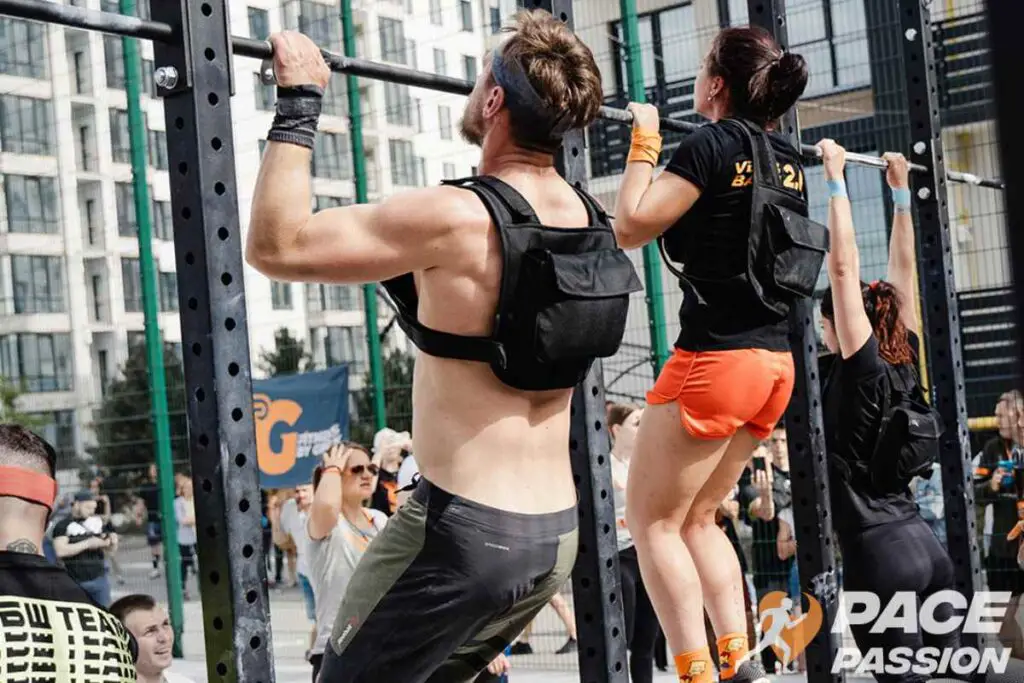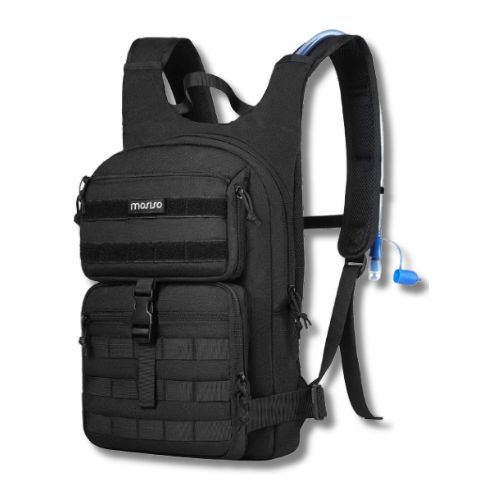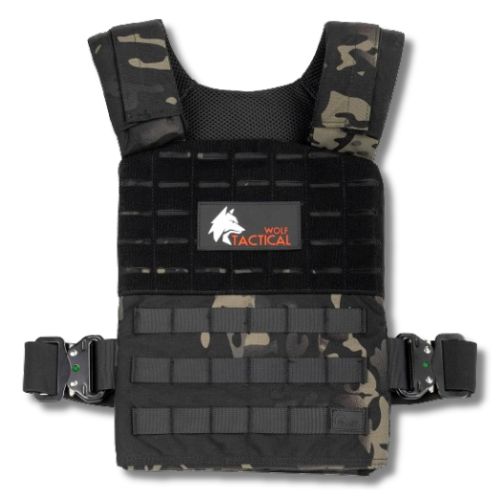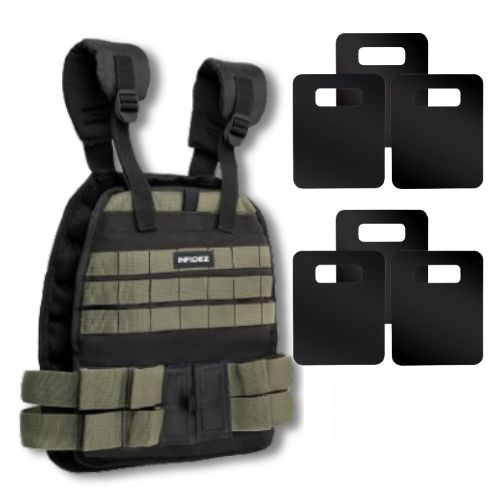Ruck Running: 5 Benefits and 3 Great Workouts
Do you want to reach your running goals faster and improve your performance? Ruck running is a full-body exercise that combines running with the load of a backpack. Not only does it burn calories, it also helps strengthen muscles and increases aerobic capacity.
This blog post provides an overview of ruck running benefits, as well as 3 effective workouts to help boost your performance, all while having fun outdoors! Ready for some action? Let’s get started!
Does Rucking Help Running?
Running with a rucksack can improve your endurance, build stronger muscles, and improve weight loss through higher calorie burn. You need to pick the right weight and adjust your gear before starting ruck running if you want to reduce potential injury risk.
What Is Ruck Running?
Ruck running is a form of exercise in which the runner carries a weighted backpack (rucksack) while running, typically over long distances. It is used to build strength and develop endurance, and is increasingly common among both military and recreational athletes.

Ruck Running Technique
Running with a rucksack combines traditional running with weight training. It involves carrying a weighted backpack, usually filled with water or other heavy items, to help increase the workout intensity.
Rucking requires runners to maintain proper posture and form in order to get the most out of each stride. This engages more muscles during the run, building strength throughout the entire body.
The key to successfully running with a backpack is having a loaded pack that’s comfortable yet challenging enough for an effective workout. Between 15-30 pounds is typically considered ideal for men, while women should aim for 10- to 20-pound packs.
Advantages and Disadvantages of Ruck Running
This exercise can provide numerous physical benefits when done correctly. However, it may also increase injury risk, cause faster burnout, and have greater joint impact than regular running. Let’s discuss this further.
Advantages of Rucking
Rucking offers a number of benefits to runners, including improved cardiovascular health, weight loss, better posture, increased endurance, and stronger muscles. It’s also cheaper than most other forms of exercise, since you don’t need any expensive equipment—just a backpack for carrying weight.
Here are the main benefits of rucking:
1. Better Posture
Rucking can help improve posture and strengthen the back and shoulder muscles for runners. By performing ruck runs, your body will learn to maintain better running form while supporting heavier loads with good posture.
This helps you reduce fatigue and prevents possible injuries due to bad muscular alignment or improper balance.
2. Weight Loss
The combination of cardio and strength training makes ruck running a high-calorie burn exercise that works your muscles. It gives you the weight resistance necessary to lose fat and gain lean muscle mass.
Utilizing this technique can increase caloric expenditure while helping you break up the monotony of traditional running routines.
3. Improved Endurance
As you maintain your running pace while carrying an additional load, it leads to significant increases in cardiovascular effort. By challenging both your aerobic and anaerobic systems with regular rucking workouts, your body adapts to become better at metabolizing energy over sustained periods of time.
This translates into improved endurance performance for runners, allowing them to go further and faster on less effort during races and other long-distance events.
4. Stronger Muscles
Running with a weighted backpack helps build strength and muscle mass in the legs, core, and back muscles. The legs are worked by constantly carrying weight as they move over varying terrain, helping to improve power delivery when running.
Core muscles such as glutes, hips, abdominals, and obliques get strengthened from stabilizing heavy weights while rucking through challenging landscapes.
The exercise also builds solid upper body muscles in the back area, making them much sturdier and increasing range of motion for even faster runs.
5. Better Cardiovascular Health
Running with a rucksack offers a range of cardiovascular benefits, including improved stamina and aerobic fitness. It is a great alternative for those with joint issues looking to improve overall physical health and cardiovascular endurance.
Long-term health benefits include lowered cholesterol levels, increased lung capacity, and reduced blood pressure.

Disadvantages of Rucking
Running with a weighted backpack can be an effective workout for many runners looking to switch up their daily routine. However, it does come with some potential risks and drawbacks that should be considered before starting a ruck running program:
1. Increased Injury Risk
Since rucking involves the use of a heavy backpack while running, runners should give careful consideration to potential injuries.
Muscles in the back can become strained from supporting added weight, as well as due to poor posture or incorrect technique. Additionally, making sudden directional changes too quickly can lead to imbalances in body positioning, which could increase the tendency for sprains or other soft tissue injuries.
2. Faster Burnout
With the weight of a loaded backpack, runners experience an increased level of resistance in their workout, leading to faster burnout and fatigue.
3. Higher Joint Impact
Ruck running puts additional stress and impact on the joints compared to regular running, which can be both beneficial and detrimental. While this increased joint impact can lead to improved strength and endurance for some runners, others may experience greater risks of injury due to pre-existing conditions in their joints.
Runners with weak leg muscles or existing issues such as plantar fasciitis should take extra caution when engaging with this high-impact activity. These runners should start slowly by gradually adding light weights during more intense runs, rather than committing fully to a session involving heavy backpacks right away.
Is Rucking Bad for You?
Not at all! Rucking is fun and gives you numerous benefits. However, beginners should still take caution when embarking on their first few ruck workouts, gradually increasing weights after consulting fitness professionals.
Experienced runners looking for a challenge may use heavier weights in order maximize results. However, they should also ensure proper form and take breaks throughout the session if needed in order to avoid any undue strain on muscles or joints.
How to Run with a Backpack
Before you start running with a backpack, make sure to pick the necessary gear and choose the correct weight for your body. Here are some simple ruck running tips to help you start:
1. Picking Proper Equipment
Rucking with an ill-fitting backpack and inadequate footwear can lead to injury, exhaustion, or even worse, ruining your whole experience.
It’s important to have a good quality, durable backpack when you plan on getting into running with a rucksack.

Pro Tip:
Look for backpacks that include features like ample storage, size adjustability, water resistance/waterproofing capabilities, and breathable materials.
The bag should be lightweight, but still capable of carrying up to 40 lbs of weight for some time without affecting posture or performance in any way. Also look for features such as two waist belts and adjustable straps across the side and chest areas for added back support while rucking.
2. Choosing the Correct Weight
For runners looking to add a rucking component into their workouts, selecting the correct weight for your backpack is essential. Beginners should start with 10-15% of their body weight and gradually increase it as they progress.
Experienced runners can benefit from greater weight that challenges them while still avoiding strain or injury—somewhere around 20-30% of their body weight for experienced male runners and 10-20% for experienced female athletes.
3. Maintaining Good Posture
Poor body mechanics can lead to wear and tear on the joints, as well as muscle fatigue and potential injury. That’s why it’s important for runners of all levels to focus on maintaining a strong, correct posture while they’re running with additional weight.
Correct form will provide stability in your core and support for back muscles, which can help reduce stress and prevent injuries over time.
Subscribe to Our Running Newsletter!
Get free running tips from renowned professional athletes and discounts from top-notch brands.
4. Proper Recovery
Getting enough rest after a run is essential in order for your body to properly recover. When you’re ruck running, it’s especially important. This will help reduce injuries and maximize the benefits of your runs.
Allowing yourself adequate time between runs gives muscles time to rebuild, heal, and increase strength before you start working out again. Overexerting yourself puts strain on the body parts that are not yet adequately trained or conditioned for running with added weight, thereby increasing injury risk.
3 Ruck Run Workouts for Runners
For those looking for a new challenge in their running regime, try out these 3 ruck run workouts that incorporate sprints, partner relays, and other strength exercises.

Workout 1: 30-Minute Ruck Hike with Interval Sprints
This is a great way to combine two excellent exercises–rucking and sprinting. Its intense cardiovascular nature builds endurance while working your core, calves, and quads. As with any form of exercise, it is important to warm up before beginning the workout.
Start out at an easy pace for 5 to 10 minutes before increasing intensity.
The main part of the workout consists of alternating between intervals of jogging and sprints for 30 minutes. During each interval (lasting 1-2 minutes), maintain a steady jog while carrying your weighted backpack, then increase intensity for the next 30 seconds by performing a sprint until you’re back in a jogging rhythm again.
Workout 2: Ruck Run Pyramid
The ruck run pyramid is a great way to increase both endurance and overall strength, particularly in the back muscles and those of the core. This workout involves 5 rounds where you run with a weighted backpack for increasingly longer periods of time at higher speeds.
The goal is to push your body to its limit and build mental toughness while also strengthening various muscle groups. Each round lasts anywhere from 1 minute to 5 minutes. This leads to both aerobic and anaerobic conditioning, further increasing endurance.
Workout 3: Partner Ruck Run Relay
Partner ruck run relay is a great way for runners to challenge themselves and vary their cardio training routines. This workout involves partnering up with someone else and taking turns carrying a weighted backpack while running, usually at different intervals. For example, one partner runs 300m while the other carries the weight, then they switch.
Not only will this help build endurance and strength in the legs and core, but it will also add variety to regular running sessions.
How to Choose a Backpack for Running
Picking the right backpack for your ruck run is critical to ensure comfort and safety, as different variables like size/fit, breathability, and weight all play an important role in getting the best result.
1. Size and Fit
Properly fitted backpacks distribute weight evenly across your back, minimizing any strain or discomfort you may experience during your workouts. Additionally, a well-fitted bag can facilitate maximum performance on the trails, while an ill-fitting load will exhaust you faster due to uneven distribution of weight and improper breathing.

Pro Tip:
The necessary features to look for include adjustable shoulder straps, chest straps for additional stability, and compression straps limiting unnecessary movement.
2. Weight
Generally speaking, it’s recommended to carry 10-15% of your body weight when starting out and gradually increasing this weight as you progress in your training.
Too much weight will cause physical discomfort that could reduce efficiency and increase fatigue during your runs. Experienced runners should aim for between 20-45% of their weight, depending on their level of conditioning. However, this depends largely on individual preference and goals, as everyone has different needs when it comes to running with a weighted backpack.
3. Breathability
Breathability allows air to circulate, helps prevent heat build-up, and reduces the risk of discomfort and skin irritation.
Features such as mesh panels, ventilated back panels, and moisture-wicking materials contribute to breathability in a backpack. Moisture-wicking materials help pull perspiration away from your skin, which can lead to better speed performance during runs, as well as improved comfort levels.
4. Compartment Layout and Use
Having multiple compartments can make organization easier, while also providing enough space to store all of your running gear without having your bag become too bulky or heavy.
Look for backpacks with dividers inside that enable you to better categorize items based on purpose and weight variations. Some backpacks also feature external mesh pockets for accessible storage, as well as attachment points that allow you to attach other gear such as helmets, tripods, or hydration bladders.
Our Recommendation of Backpack for Ruck Running
For those looking for the best running backpacks, we recommend the following 3 options that we think deserve your attention:
- Tactical Hydration Pack Backpack MOSISO. The advantage of this rucksack is that it serves as the simplest type of rucksack for running with minimal weight, provided that 3 liters of water are added. In fact, the weight here is more of a secondary function, so this model will be convenient for beginners who are not yet confident or want to run with weight.
Lightweight Daypack Water
MOSISO Tactical Hydration Pack Backpack
The MOSISO bag measures 17.32 x 11.69 x 3.75 inches and is made from the durable 600 Denier Polyester material, making it ideal for long-term use in any environment. It also includes an easy access pocket on the top and two side pockets.
Additionally, the bag contains a 3L water bladder, allowing runners to stay hydrated during their workouts. It features support foam straps that can be adjusted according to different body heights, meaning both men and women can benefit from wearing it.
Material:
Durable and water-resistant fabric
Durability:
Built to withstand rugged use
Closure Type:
Zipper and buckle closure
Comfort:
Padded shoulder straps and breathable back panel
Weight Type:
Lightweight and ergonomic design
Special Features:
Integrated hydration reservoir compatible
Best For:
Outdoor activities, rucking and hiking
2. The Weighted Vest WOLF TACTICAL for running and workouts. The advantages of this vest for runners are the use of high-quality materials for the manufacture of the vest itself, as well as the optional addition of plates for load control.
Strength Training Weight Vest
WOLF TACTICAL Quick-Release Weighted Vest for Men
The WOLF TACTICAL Vest is perfect for men who are looking to take their running performance to the next level. This weighted vest features premium heavy-duty materials and oversized airflow panels for breathability and a contoured fit.
Additionally, it comes with 5 pairs of vest plates, ranging from 5.75lbs (for beginners) all the way up to 14.5lbs (for advanced athletes). With its durable construction and adjustable weights, you won’t feel weighed down during long runs or high-intensity workouts.
Material:
Rugged and high-quality fabric
Durability:
Designed for durability in tough conditions
Closure Type:
Quick-release buckles for easy on/off
Weight Type:
Adjustable weight plates
Comfort:
Adjustable and padded shoulder straps
Special Features:
Quick-release, adjustable weight distribution
Best For:
Resistance training, fitness, and strength workouts
3. The Tactical Adjustable Weighted Vest INFIDEZ. The advantages of this vest are the convenient configuration: the vest itself (weighs 12 pounds) and 4 plates (2.5 pounds each). This allows you to control the load for runners, depending on the level of training. It is also worth noting that the vest is made of materials resistant to dirt, sweat and moisture, which allows it to be used for running at different distances and in different weather (within reason).
Weighted Vest with 4 Weight Plates
INFIDEZ Tactical Adjustable Weighted Vest
The INFIDEZ Tactical Adjustable Weighted Vest is an ideal choice for men looking to enhance their strength training and running performance. This vest has an adjustable weight range of 12–22lbs for a lighter option and 16-31lbs for a heavier one, so it can be tailored to any fitness level.
The included weight plates are heavy-duty 2.5 lbs steel powder-coated plates with 8×10 inch dimensions. They also have a quick release feature, making them easy to take off during workouts without.
Material:
High-quality and durable materials
Durability:
Designed for rugged and long-lasting use
Closure Type:
Adjustable, secure Velcro and buckle closures
Weight Type:
Adjustable weight pouches
Comfort:
Padded and adjustable shoulder and waist straps
Special Features:
Modular and customizable weight distribution
Best For:
Intense training, fitness, and strength exercises
Frequently Asked Questions About Running with a Backpack
Can I Wear a Backpack While Running?
Absolutely. Wearing a backpack while running can be an effective way to add resistance and help improve your overall performance. It is a form of rucking, which builds strength and endurance and fortifies joints and muscles, providing a beneficial addition to your running routine.
Does Running with a Backpack Slow You Down?
Carrying extra weight while running can affect stride and pace and may cause a decrease in speed. Depending on the backpack’s size, total weight, and where it sits on your body, running with a backpack could slow you down.
Final Thoughts on Ruck Running
Ruck running can be beneficial for all levels of runners, from the beginner who is looking to tone up and get some fresh air to the seasoned runner seeking new challenges. Overall, rucking offers a safe and effective way to increase strength while doing cardio exercise.
It also helps strengthen core muscles that directly improve postural health. Moreover, it works out your legs effectively.
Thankfully, this effective workout also requires minimal equipment, so there are no excuses not to give it a go!
Have you ever tried ruck running? Please share your experience in the comments below.
Also Read:
- Protein Shake After Running
- Running for Seniors
- 100 Miler Training Plan
- Do Nikes Run Big or Small
- Good 10K Time
- Best Shoes for Peroneal Tendonitis
- 2 Miles Is How Many Steps
- Are Basketball Shoes Good for Running
- How Far is 14000 Steps
References:
- Wills JA, et al. Load-Carriage Conditioning Elicits Task-Specific Physical and Psychophysical Improvements in Males. J Strength Cond Res. 2019 Sep. https://journals.lww.com/nsca-jscr/fulltext/2019/09000/load_carriage_conditioning_elicits_task_specific.5.aspx
- Bloch AE, et al. Effect of Fatigue on Movement Patterns During a Loaded Ruck March. Mil Med. 2023 Apr 21 https://academic.oup.com/milmed/advance-article/doi/10.1093/milmed/usad086/7135526?login=false
- Wills JA, et al. Physiological Responses of Female Load Carriage Improves after 10 Weeks of Training. Med Sci Sports Exerc. 2020 Aug. https://journals.lww.com/acsm-msse/fulltext/2020/08000/physiological_responses_of_female_load_carriage.14.aspx
- Knapik JJ, et al. A systematic review of the effects of physical training on load carriage performance. J Strength Cond Res. 2012 Feb. https://journals.lww.com/nsca-jscr/fulltext/2012/02000/a_systematic_review_of_the_effects_of_physical.36.aspx
- Orr R, et al. Soldier Load Carriage, Injuries, Rehabilitation and Physical Conditioning: An International Approach. Int J Environ Res Public Health. 2021 Apr https://www.mdpi.com/1660-4601/18/8/4010
If you have any questions or suggestions, you can contact us via email – [email protected]









